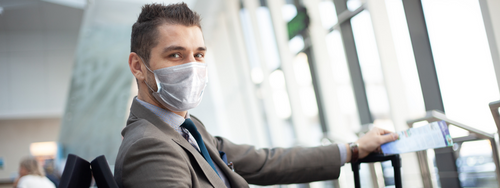Share:
This year, your ritual when you leave your house likely gained a new addition: you check for your wallet, keys, phone, and now your face mask. During the COVID-19 pandemic, people have been urged to stay at home and practice social distancing, but scientific research and studies say it’s not enough. Face masks are portable physical barriers that primarily protect others from the microbes that spread through airborne transmissions when you talk, sneeze, or cough. More advanced face masks will also shield you from incoming viral respiratory droplets.
As of right now, many states have made wearing face masks in public mandatory, and where it’s not required it’s strongly recommended. We’ll examine why face masks took time to catch on in the US, the science of how they work to reduce viral spreading, and the criteria you should look for to get the most out of your mask usage.
Why we didn’t embrace masks at first
At the beginning of the pandemic, organizations like the CDC claimed that the average citizen didn’t need to wear face masks and surgical and N95 masks should be saved for healthcare workers. Additionally, experts weren’t aware of how people could have coronavirus without showing or experiencing any symptoms—therefore it was hard to tell who was infected. Infectious disease specialist Peter Chin-Hong, MD, offers another explanation on why people were confused about masks: “Culturally, the U.S. wasn’t really prepared to wear masks, unlike some countries in Asia where the practice is more common.” However, scientific organizations made an about-face once infection rates skyrocketed and proof of asymptomatic and pre-symptomatic transmission surfaced. Now the CDC recommends people wear cloth face masks to reduce the spreading of the virus, especially in public.
How do face masks work?
The National Academy of Sciences (NAS) recently published new research that reveals the highly virulent nature of COVID-19 and the efficacy of face masks. The research identified that airborne transmission is the dominant route to spread the disease given that people are quarantining, hand sanitizing, and isolating themselves en masse. Coughing, sneezing, and even normal breathing and talking spread the coronavirus through aerosol transmission—tiny particles or liquid droplets in the air. According to the NAS, “Face covering prevents airborne transmission by blocking atomization and inhalation of virus-bearing aerosols and contact transmission by blocking viral shedding of droplets.” The researchers analyzed the trends of infection rates in the epicenters of the pandemic: Wuhan, China, Italy, and New York City. They found that infection rates in Italy and NYC only started to slow after face masks were made mandatory. The study concluded that wearing face masks in public is among the most effective means to prevent interhuman transmission, specifically airborne transference.
Standard cloth face coverings aren’t guaranteed to protect the wearer, but they keep the wearer from spreading the virus to others. The types of cloth masks that will best protect the wearer from others are those that are lab tested to have high levels of filtration efficiency. To protect the wearer from the virus and be comfortable and durable, there are certain key properties you should look for in face masks.
What to look for in a face mask
We’ve previously discussed six types of COVID masks and how reusable each type is. You’ll likely select your face mask based on the type of environment you’re in at home, in public, and at work. For example, it’s well-known that N95 respirators are best left to healthcare workers/first responders and people who work in industrial settings. Those who don’t fall into those categories should use cloth face coverings or surgical-style masks available at drugstores and convenience stores.
Comfortability is another major criterion when selecting a mask. For cloth masks, according to NPR, experts say to focus on the fabric, fit, and breathability. For the fabric, the tightness of the fabric’s weave is important. To check this, hold your mask up to a light. If you can easily see the outline of the individual fibers, the mask won’t be a good filter. The best kind is a mask that is a tight-weave 100% cotton mask as opposed to a mask made out of synthetic fibers. However, when it comes to filtration capabilities, cotton masks can come up short compared to other kinds, filtering out only 35 percent of particles. If you’re looking for a mask with optimal filtration abilities, OURA’s Air Mask filters out 95 percent of viral particles and bacteria and kills incoming pathogens.
For fabric masks, scientific experts suggest that a mask with multiple layers is more effective for blocking small particles. Specifically, a good option is a mask made of two layers of a tight-weave fabric and a pocket where you can insert a filter. For filters, the best material to look for is polypropylene, a plastic-based material commonly found in surgical masks and N95 respirators.
You also need to ensure the correct fit and covers your mouth and nose. For cloth masks, those that cup tightly to your face are best for protection. Johns Hopkins Medicine recommends the mask have earloops or ties to adjust it and make sure it’s snug. If you wear glasses, you should find masks with an adjustable nosepiece at the top to mold the mask to fit your nose and prevent your glasses from fogging. To make sure your mask remains effective, regularly wash your mask with soap and water.
Final thoughts
Remember, face masks aren’t a substitute for social distancing. However, right now they are one of the most effective tools we have at our disposal to fight this virus. Wearing face masks in conjunction with social distancing, quarantining, hand washing, and minimizing contact are the best ways to reduce the spread of the coronavirus. The more that people adopt and follow these preventative measures, the more of a chance we have to decrease infection rates and return to pre-COVID normality.




